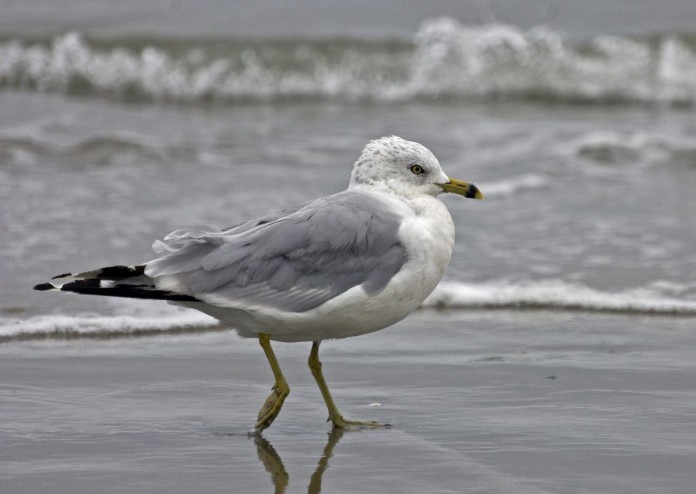If your summer vacation plans include a trip to an East Coast beach, I can’t predict everything you might see, but one bird that I guarantee you’ll encounter many times is the laughing gull.
Laughing gulls
I’ve been visiting the beaches of southern New Jersey almost every year since I was a boy, and if Jersey beach resorts had a mascot, it should be the laughing gull. They’re everywhere. Early in the morning just after dawn, they patrol the surf zone foraging for crabs and small fish. If a smaller tern flies by with a mouthful of food, they often harass the tern and force it to drop its meal.
At mid-day when the beach is filled with sunbathers, laughing gulls escape the chaos on bay side islands, but at dinner time, as the crowds begin to thin, they return. And they’ve learned that people are a great source of junk food.
Laughing gulls find bread, popcorn, and pretzels irresistible, and sometimes swoop in by the blanket and grab treats from outstretched fingers.
At 17 inches long with a 40–inch wingspan and weighing just 11 ounces, laughing gulls are medium sized gulls with black heads, white eye-rings, and red bills. They are handsome birds and, because they preen frequently, rarely is a feather out of place. Plus, they can immediately be recognized by their loud, laughing voice.
Ring-billed gulls
Several other gulls are commonly seen at east coast summer beaches and again I can guarantee you’ll see them this time of year. Ring-billed gulls have white heads, gray backs, measure about 18 inches long with a 48-inch wingspan, weigh just over a pound, and have a telltale dark ring near the tip of the yellow bill.
Herring gulls are similar, but at 25 inches with a 58-inch wingspan and weighing 2.5 pounds, noticeably larger. The herring gull’s yellow bill is marked by a red spot near its tip.
Herring gulls
Both herring and ring-billed gulls also occur inland. In fact, just last week I saw a report that there were at least 15 active herring gull nests on the Allegheny River near Pittsburgh.
In mid winter, when thousands of gulls gather to roost on frozen rivers, most are ring-billed gulls. And these are the gulls that often gather at landfills, garbage dumpsters, and fast food restaurants. When you see gulls scavenging food inland along major rivers, they are usually ring-billed gulls.
Black-back gulls
The great black-backed gull is a huge bird that at a distance might initially be mistaken for a bald eagle. Great black-backs measure 30 inches long, with a 65-inch wingspan, and weigh about 3.6 pounds. The yellow bill is massive and marked by a red spot at the tip. When seen with other gulls, great black-backs stand out by size alone.
Great black-backed gulls are highly predatory and can swallow young waterfowl and small seabirds whole. I once saw one on a bay in Maine menace a hen common eider and her brood. Ultimately it grabbed the smallest duckling and swallowed it in one gulp.
Occasionally I’ve seen lone great black-backs on the beach, but more often I’ve seen them at boat docks and near seafood restaurants on the water. I suspect they clean up debris from fishing boats and tourists’ dinners.
Terns
Though usually much smaller than gulls, several species of terns frequent east coast beaches. Usually I see them fishing just off shore. Their flight is buoyant, and they often hover just before dropping into the water to grab a small fish.
As the name suggests, common terns (12 inches long, 30-inch wingspan, 4 ounces) are the most likely terns to be seen. The black cap and red bill are distinctive.
Least terns (nine inches long, 20-inch wingspan, 1.5 ounce) are half the size of a blue jay, so their diminutive size and white forehead make them easy to recognize. Because they nest on the same sandy beaches that tourists enjoy, they are most often seen from behind fences on protected beaches off limits to the public.













